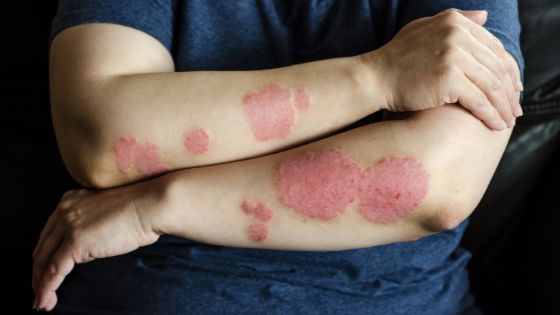Psoriasis is a type of skin disorder that causes rashes and scaly patches on the skin. It is a type of auto-immune disease and mostly appears on the elbows, knees, and scalp. In this skin disorder, the skin cells start multiplying rapidly. Due to the abnormal growth, the skin builds up into bumpy red patches with white scales. It is a type of long-term disease and can appear in cycles. The typical psoriasis scales are whitish-silver. But on a dark skin tone, the scales can appear brownish with gray scales. These patches can crack and bleed. This skin condition is not transferable, however, it can run in families. The life cycle of a skin cell is for about 1 month. But in psoriasis, the skin production speeds up and the new cells start producing in a few days. Due to this, the skin cells don’t get the time to fall off and get built up. Most people get this psoriasis in their early adulthood. The condition may be affected for a few years. But when the psoriasis is severe, it can reoccur again and again. The patches can also cover large parts of the body.

Types of psoriasis
Pustular psoriasis
In this type of psoriasis, the skin becomes red with scales. People get tiny pustules on the palms and soles of the feet. It is a rare type of psoriasis.
Guttate psoriasis
This type of psoriasis often appears in childhood. It causes small red spots on the torso and limbs. Guttate psoriasis is mainly triggered due to bacterial infections like strep throat. Some other factors that can trigger guttate psoriasis are stress, skin injury, and certain medications. The marks in guttate psoriasis are small with scaling spots and drop-shaped. Guttate psoriasis usually occurs on the trunk, legs, and arms.
Plaque Psoriasis
This is the most common type of psoriasis where the skin becomes dry and itchy with raised skin patches. Plaque psoriasis appears in the knees, elbows, scalp, and lower back. The patches of plaque psoriasis depend on the skin type. The psoriasis-affected area heals with temporary color changes.
Inverse Psoriasis
Inverse psoriasis appears on the skin folds. The commonly affected areas are the groin, buttocks, and breasts. The skin gets inflamed with smooth patches. Inverse psoriasis condition may get worse due to sweating and friction. This psoriasis is mainly triggered by a fungal infection.
Erythrodermic psoriasis
This is a rare type of psoriasis that covers the whole body. The body gets covered with itchy and peeling rashes. This is usually an acute condition but sometimes it may get chronic.
Nail psoriasis
Psoriasis condition also affects the nails. It can occur in fingernails and toenails. In nail psoriasis, the nails start growing at an abnormal rate and discoloration. The nails may get loosen or separate from the nail bed.
Symptoms of Psoriasis
Patchy rashes on the skin. The patches may look like small spots or can occur in big areas.
The color of rashes depends on the skin shades. In the lighter shade, the patches of psoriasis appear pink or red with silver scales whereas, in darker skin tones, these patches appear purple with gray scales.
In kids, psoriasis usually appears like small and scaling spots
- Itching
- Soreness
- Burning
- The rashes appear in cycles
- Psoriasis can last for a few weeks or months
Causes of psoriasis
The exact cause behind psoriasis is unknown. But some research shows that psoriasis can appear due to two factors, immune system and genetics.
Immune system
It is an autoimmune condition. A person gets an autoimmune condition when the body is attacking itself. In psoriasis, the white blood cells mistakenly start attacking the skin. In a body, the white blood cells attack and destroy the bacteria that are attacking the body. These cells are like the defense against infection. Due to the autoimmune attack, the skin cells start producing speedily. The new skin cells produce quickly and push the skin’s surface to pile up. Due to this condition, the skin becomes red and inflamed.
Genetics
Some people can also inherit psoriasis from genetics. If any person has an immediate member with psoriasis condition, he is at a high risk of developing the same condition.
Homeopathic treatment for psoriasis
Homeopathy is considered one of the best options to treat psoriasis. As you know homeopathy works on the “like cure like” principle. In this type of dynamic medication, your doctor works on treating the root cause behind the condition. With a good psoriasis treatment Pennsylvania, you can reduce all the symptoms of this skin condition. Most people adopt homeopathy because it is a type of natural medication. People don’t have to face any kind of harmful side effects while treating psoriasis with homeopathy.
Common homeopathic medicines to treat psoriasis are:
Sepia
This is the most common homeopathic remedy for psoriasis. It helps in treating widespread psoriasis and dry skin. Homeopaths often prescribe sepia when the itching and burning sensation is getting worse due to bath and warmth.
Arsenicum album
This homeopathic remedy is prescribed when the person is getting symptoms like restlessness and anxiety. Some people also get symptoms like burning pains or deep chills. The skin gets too dry and scratching makes it worse. Arsenicum album reduces the symptoms and provides good relief.
Petroleum
Your doctor will prescribe petroleum remedies for those who are also facing stress due to psoriasis. This remedy is very helpful when the person is facing symptoms like extremely dry and scaly skin. Itching makes the condition worse but applying heat provides relief. Petroleum reduces the itchiness and provides moisture to the skin.
Graphites
This remedy is very helpful for treating long-term skin disorders. The skin looks cracky and may also bleed sometimes. Graphites help in reducing the symptoms and the person can easily concentrate on other jobs.
Some other homeopathic remedies for psoriasis are sulphur, calcarea carbonica, mercurius solubilis, mezereum, rhus toxicodendron, and staphysagria.
